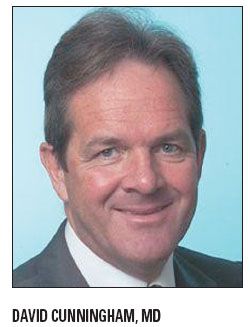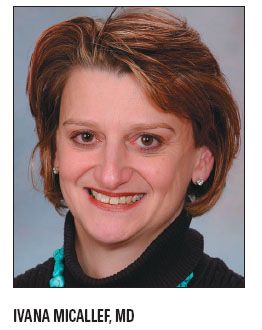Updated regimens on par with standard therapy in diffuse large B-cell lymphoma
Researchers are exploring ways to manipulate rituximab (Rituxan) when added to the current standard therapy for diffuse large B-cell lymphoma, specifically shortening the number of treatment days. Preliminary results of a phase III trial showed that rituximab plus CHOP over a 14-day cycle achieved similar response rates and comparable toxicity compared to CHOP on a 21-day cycle in newly diagnosed patients.
Researchers are exploring ways to manipulate rituximab (Rituxan) when added to the current standard therapy for diffuse large B-cell lymphoma, specifically shortening the number of treatment days. Preliminary results of a phase III trial showed that rituximab plus CHOP over a 14-day cycle achieved similar response rates and comparable toxicity compared to CHOP on a 21-day cycle in newly diagnosed patients.
Also, a phase II study showed encouraging results for the addition of epratuzumab (LymphoCide) to R-CHOP 21 in aggressive DLBCL.
Although findings from these studies have been favorable, R-CHOP 21 remains the standard of care for DLBCL until further studies are conducted, according to an expert opinion.

R-CHOP 14 vs R-CHOP 21
“We wanted to determine if the addition of rituximab to CHOP 14 could improve outcome compared to R-CHOP 21,” explained David Cunningham, MD, head of the gastrointestinal and lymphoma units of the Royal Marsden NHS Foundation Trust in London.
Patients with newly diagnosed DLBCL were randomized to receive eight cycles of R-CHOP 21 (n = 540) or six cycles of R-CHOP 14 (n = 50) with rituximab given for two additional cycles. Growth factor support was given to patients in the R-CHOP 14 arm on days four through 12 of each cycle. Patients were stratified according to International Prognostic Index (IPI), age, and treatment center (ASCO 2009 abstract 8506).
More than 1,000 patients were recruited at 119 treatment sites between March 2005 and November 2008. The two arms of the study were well balanced for prognostic factors, age, sex, performance status, and disease characteristics.
Overall response rates for complete response (CR) and unconfirmed CR (CRu) were 63% for the R-CHOP 21 arm and 58% for the R-CHOP 14 arm. When response was defined as CR/CRu/partial response (PR), response rates for the two arms were 88% and 91%, respectively. R-CHOP 14 had comparable response rates in favorable, intermediate, and high-risk patients, Dr. Cunningham said.
At a median follow up of 17 months, 150 deaths were reported (14%). The total number of deaths/progressions/relapses was 209 (19%). The main cause of death was disease-related conditions. For the whole study cohort, survival is better than expected, Dr. Cunningham said. Two-year failure-free survival for the entire study population is 74%, and two-year overall survival (OS) is 81%, whereas historical two-year survival is about 70%, he noted.

“Response rate is clearly a surrogate marker for outcome for this disease. Failure-free survival was significantly worse in patients with stable disease or progressive disease on therapy, whereas patients with complete remission and unconfirmed complete remission fared remarkably similar,” he noted.
The incidence of neutropenia and febrile neutropenia were lower in the R-CHOP 14 arm because of the routine use of growth factor support, while the incidence of thombocytopenia was slightly higher (see Table).
Epratuzumab plus R-CHOP 21
Epratuzumab and R-CHOP 21 (ER-CHOP) increased survival in patients with aggressive DLBCL, including those with high-risk disease, according to final results of the phase II NCCTG NO489 study. Toxicity was manageable with this regimen, with little added toxicity compared with historical data on R-CHOP 21. “These results are promising, and we hope ER-CHOP will be an advance over current treatments for patients with this cancer. We can’t say it is an advance yet, because the two regimens [ER-CHOP and R-CHOP] haven’t been tested head to head,” said lead author Ivana Micallef, MD, a hematologist at the Mayo Clinic in Rochester, Minn. A randomized head-to-head comparison of ER-CHOP vs R-CHOP is currently under discussion.
The NO489 study supported the concept of combining two monoclonal antibodies that attach to two different proteins on the surface of B cells: CD20 for rituximab and CD22 for epratuzumab, she explained. “These drugs are designed to shut down B cells, whether they are involved in autoimmunity or are malignant,” Dr. Micallef said.
Eighty patients were enrolled in the phase II study. Patients received ER-CHOP for six 21-day cycles and then were observed. Growth factor support was given at the discretion of the treating physician. The 12-month event-free survival was 79%, 12-month progression-free survival (PFS) was 87%, and OS was 89%. In the 39 high-risk patients, PFS was 77%, and for the 39 low-risk patients, PFS was 88% (abstract 8508).
As assessed by CT scan, CR/CRu was 71% and PR was 23%, for an overall response rate of 94%. Response according to PET scan was 87% for CR and 9% for PR, for on overall response rate of 96%. Dr. Micallef said that these results with ER-CHOP compare favorably with prior studies of R-CHOP.
VANTAGE POINT
ER-CHOP has pluses, but don't abandon R-CHOP 21.
John P. Leonard, MD
Although many oncologists are adopting R-CHOP 14, more time is needed to determine how well it holds up against the current standard, said Dr. Leonard, chief of the Lymphoma/Myeloma Service at Weill Medical College, Cornell University in New York.
“In my mind, R-CHOP 21 remains the current standard. More time will tell us about how these two regimens compare,” he said. Overall, Dr. Leonard praised the study’s strengths, such as its size, inclusion of all ages, statistical power, and sufficient follow-up time before presenting survival results.
Regarding the ER-CHOP regimen, Dr. Leonard said that although NO489 is a phase II study, the efficacy was high and compares favorably with other historical data. He agreed that a randomized controlled trial was needed to compare ER-CHOP with R-CHOP 21.
“I am not yet ready to abandon R-CHOP 21. In these studies, patients who do worse are those who do not respond,” he said. In at least 50% of those in whom these regimens fail, the failure is within the first six months. To progress beyond R-CHOP 21, new strategies are needed to reverse progression within the first six months, Dr. Leonard commented.
Newsletter
Stay up to date on recent advances in the multidisciplinary approach to cancer.
Highlighting Insights From the Marginal Zone Lymphoma Workshop
Clinicians outline the significance of the MZL Workshop, where a gathering of international experts in the field discussed updates in the disease state.
Expanding Horizons in T-Cell Lymphoma Therapy: Focus on Personalized Treatment Strategies
Several lymphoma experts discuss the current T-cell lymphoma landscape, the need for new therapies, and ongoing research in the space.